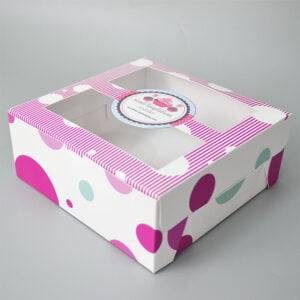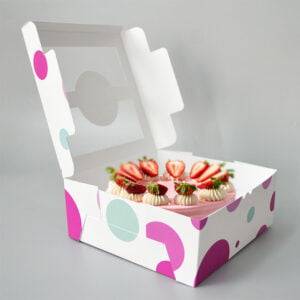In the world of confectionery and baked goods, the shelf life of cakes is a critical consideration for both bakeries and consumers. The right packaging plays a pivotal role in preserving the freshness, flavor, and quality of cakes over time. In this comprehensive guide, we will explore the various factors that affect the shelf life of cakes and how proper packaging techniques can extend the duration for which cakes remain delectable and safe for consumption.
Understanding the Shelf Life of Cakes
 Before we delve into packaging strategies, it’s essential to understand what determines the shelf life of cakes.
Before we delve into packaging strategies, it’s essential to understand what determines the shelf life of cakes.
Factors Affecting Shelf Life
- Ingredients: The quality and freshness of ingredients used in cake preparation directly impact its shelf life. High-quality ingredients and careful sourcing contribute to a longer shelf life.
- Moisture Content: The moisture content of cakes can influence how long they stay fresh. Cakes with excessive moisture are more susceptible to mold and spoilage.
- Preservatives: Some cakes may contain natural or artificial preservatives, which can extend their shelf life. However, consumer preferences are shifting towards preservative-free options.
- Storage Conditions: How cakes are stored—temperature, humidity, and exposure to light—all play a significant role in their shelf life.
- Packaging: The type of packaging used, its quality, and how well it seals the cake are crucial factors. Proper packaging can significantly extend the cake’s shelf life.
Packaging Strategies to Maximize Cake Shelf Life
Let’s explore effective packaging strategies that can help you maximize the shelf life of cakes:
1. Choose the Right Packaging Material
Selecting the appropriate packaging material is the first step. Ideal materials include:
- Cake Boxes: Sturdy and moisture-resistant cake boxes protect cakes from physical damage, dust, and humidity. They are available in various sizes to accommodate different cake dimensions.
- Cake Wraps: Plastic wraps or food-grade cellophane can be used for individual slices or smaller cakes. Ensure they are airtight to prevent moisture loss.
- Vacuum-Sealed Bags: For larger cakes or those intended for longer storage, vacuum-sealed bags remove air and create an airtight environment, preserving freshness.
- Tin-Tie Bags: These resealable bags with tin ties are suitable for packaging slices or small cakes. They allow for resealing, maintaining freshness after initial opening.
2. Use Cake Boards and Cake Drums
Cake boards and drums provide a stable base for cakes and offer an additional layer of protection. They prevent the cake from absorbing moisture from the packaging and help maintain its shape during storage and transport.
3. Invest in Airtight Sealing
Airtight sealing is crucial to preventing moisture loss and keeping cakes fresh. Ensure that the packaging, whether it’s a box, wrap, or bag, provides a secure and airtight seal. You can use food-safe adhesive tapes or stickers to seal boxes and bags effectively.
4. Temperature Control
 Maintaining the right temperature is paramount for cake shelf life. Store cakes in a cool, dry place, away from direct sunlight and heat sources. Refrigeration is suitable for cakes with perishable fillings, but it’s essential to use airtight containers to prevent absorption of odors.
Maintaining the right temperature is paramount for cake shelf life. Store cakes in a cool, dry place, away from direct sunlight and heat sources. Refrigeration is suitable for cakes with perishable fillings, but it’s essential to use airtight containers to prevent absorption of odors.
5. Consider Vacuum Packaging
Vacuum packaging machines can remove air from packaging, creating a vacuum seal that preserves the cake’s freshness. This method is particularly effective for extending the shelf life of cakes with cream or fruit fillings.
6. Protective Layers
For delicate cakes with intricate designs or frostings, consider adding a protective layer within the packaging. This can be a cardboard collar or a cake sleeve that shields the cake’s surface from coming into direct contact with the packaging.
7. Labeling and Date Marking
Clearly label each cake package with essential information, including the date of production and the cake’s flavor or type. This helps both bakery staff and customers identify the freshness of the cake and its contents.
8. Handle with Care
During transport and handling, ensure that cakes are kept level and stable to prevent shifting and damage. Fragile cakes may require additional packaging materials, such as foam inserts or supports, to maintain their integrity.
FAQ: Frequently Asked Questions
Q1: How long can I store cakes in the refrigerator, and do all cakes need refrigeration?
A1: The storage duration in the refrigerator varies depending on the type of cake. Cakes with perishable fillings, such as cream or custard, should be refrigerated and are typically best consumed within 3-5 days. However, most cakes without perishable fillings can be stored at room temperature for 2-3 days. Always follow specific storage guidelines for each cake type.
Q2: Can I freeze cakes for long-term storage?
A2: Yes, cakes can be frozen for extended storage. To freeze a cake, wrap it tightly in plastic wrap and place it in an airtight container or a vacuum-sealed bag. Properly frozen cakes can remain fresh for several months. Thaw them in the refrigerator before serving.
Q3: What should I do if I notice mold on a cake?
A3: If you observe mold on a cake, it’s crucial to discard the entire cake, including any slices that may have been in contact with the contaminated area. Mold can produce harmful toxins that can be harmful if ingested.
Q4: How can I refresh a cake that has lost moisture?
A4: To refresh a cake that has become dry, consider brushing it lightly with a simple syrup made from equal parts sugar and water. This can add moisture and flavor to the cake. Additionally, frosting or icing can help restore moisture to the cake’s surface.
Q5: Are there special considerations for packaging gluten-free or allergen-free cakes?
A5: Yes, if you are packaging gluten-free or allergen-free cakes, it’s essential to use packaging materials that are free from allergens and have not come into contact with allergenic ingredients. Clearly label the packaging to indicate the cake’s gluten-free or allergen-free status.
In conclusion, the shelf life of cakes is a crucial aspect of bakery management, and the right packaging techniques can make a significant difference. By choosing the right packaging materials, maintaining proper temperature control, and ensuring airtight sealing, bakeries can extend the freshness and quality of their cakes, delighting customers with each delicious bite.
